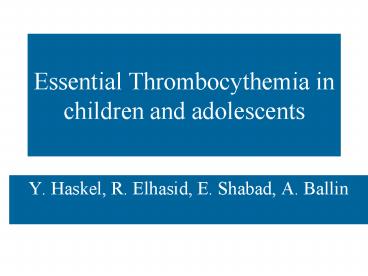Essential Thrombocythemia in children and adolescents - PowerPoint PPT Presentation
1 / 11
Title:
Essential Thrombocythemia in children and adolescents
Description:
Essential Thrombocythemia in children and adolescents Y. Haskel, R. Elhasid, E. Shabad, A. Ballin Background E. T. is an uncommon myeloproliferative disorder ... – PowerPoint PPT presentation
Number of Views:161
Avg rating:3.0/5.0
Title: Essential Thrombocythemia in children and adolescents
1
Essential Thrombocythemia inchildren and
adolescents
- Y. Haskel, R. Elhasid, E. Shabad, A. Ballin
2
Background
- E. T. is an uncommon myeloproliferative disorder,
characterized, mainly, by increased number of
platelets and tendency to clot formation and / or
bleeding. - E. T. may terminate in AML or pure red cell
aplasia. - Thromboembolic complications may be fatal.
- E. T. is rare in children and adolescents.
- High / low (?) risk of thrombosis in young
adults.
3
Background (contin.)
- The clinical picture of pediatric E. T.
- - asymptomatic (lower PLT)
- - headache, bleeding, Thrombotic events.
- - Physical exam splenomegaly, hepatomegaly
- - Familial thrombocythemia - lower PLT counts, no
thrombotic events and no malignancies (auto-dom). - -
4
Background (contin.)
- Thrombopoietin level - normal (increased
sensitivity in vitro ?). - Cytogenetic studies - normal
- Treatment aspirin, Hydrea, Anagrelide (!), IFN
alfa - 2/36 (6) patients developed AML (similar to
adults). - mortality - 11
5
(No Transcript)
6
The aim of the study
- To assess the incidence of E.T. in the pediatric
population in Israel. - To describe the clinical picture and the natural
history of the disease in children and
adolescents.
7
Methods and patients
- Retrospective review of all charts of pediatric
patients (to age 18 y) in Israel, diagnosed to
suffer from E.T. between Jan. 1990 and Dec. 2001. - E. T. - Platelet number gt600000/mL, normal RBC
mass, no Philadelphia chromosome and absence of
any etiology for secondary thrombocytosis. - Demographic and clinical data were compared
between the pediatric patients and randomly
chosen adults with E. T.
8
Results (I)
- Four children and adolescents were diagnosed to
have E. T. - Two boys and two girls
- Median age 11 y (7-15 y)
- The incidence of pediatric E. T. in Israel is
approximately 1 500,000 - Median follow-up 5.5 years.
- No death / serious hematological sequel occurred.
9
Results (II)
- Hematological data at presentation
- pediatric pts
adult pts - platelet, med. 1754 (1038-4500) 735
(573-1249) - MPV, median 8.7 (8.1-8.8) 9.9
(8.6-10.1) - Hgb, median 12.7 (12.4-15.7) 13
(12.6-14.4) - leukocytes 10600 (7200-14300) 9350 (7820-10840)
- normal aggregation of platelets
- collagen 4
4 - adrenalin 0
0 - ADP 1
2
10
Results (III)
- All pediatric E. T. patients were treated with
aspirin and Hydrea or Agrylin. - All pediatric patients are doing well.
- Two of them need no chemotherapy now.
- The adults patients with E. T. are dependent on
the treatment. All suffer from side effects of
Hydrea or Agrylin.
11
Summary
- 1) E. T. is a rare disease in the pediatric
population. - 2) Unlike adult patients with E. T., children and
adolescents have a mild course of the disease
with no complications or any hematological
disorder. - 3) Further investigation is warranted to better
characterize E. T. in children and adolescents.

